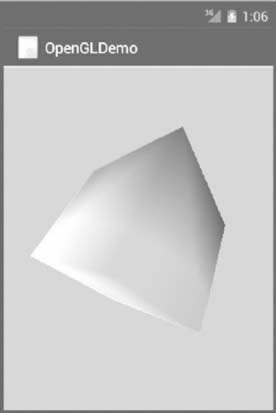Android 3D绘图开发简介
3D图像的绘制使用的是 OpenGL ES,所以我们先介绍 OpenGL ES。
OpenGL 是一组跨平台的 3D 图像处理 API,OpenGL ES 是 OpenGL 的嵌入式版本,Android 系统从 Android 1.0 开始支持 OpenGL ES 1.0 和 1.1,自 Android 2.2(API Level 8)开始,Android 框架开始支持 OpenGL 2.0 API。
在这里仅介绍其使用方法。详细资料可以查询 Android SDK 的相关文档。
使用 OpenGL ES API 绘制 3D 图像有两个基础的相关类,一个是 GLSurfaceView 类,另一个是 GLSurfaceView.Renderer 接口。
该接口实现以下三个方法。
实例 OpenGLDemo 演示了在 Activity 中使用 GLSurfaceView 和 GLSurfaceView.Renderer 合作绘制三维图形的过程。
该实例绘制了一个不断旋转的立方体,运行效果如图 1 所示。

图 1 实例OpenGLDemo的运行效果
该立方体为 MyCube 类的对象。MyCube.java 的代码如下:
OpenGL 是一组跨平台的 3D 图像处理 API,OpenGL ES 是 OpenGL 的嵌入式版本,Android 系统从 Android 1.0 开始支持 OpenGL ES 1.0 和 1.1,自 Android 2.2(API Level 8)开始,Android 框架开始支持 OpenGL 2.0 API。
在这里仅介绍其使用方法。详细资料可以查询 Android SDK 的相关文档。
使用 OpenGL ES API 绘制 3D 图像有两个基础的相关类,一个是 GLSurfaceView 类,另一个是 GLSurfaceView.Renderer 接口。
1)GLSurfaceView 类
GLSurfaceView 类是 SurfaceView 的子类,使用内嵌的 Surface 进行 OpenGL 绘图渲染。GLSurfaceView 提供以下功能:- 管理 Surface,Surface 是一块内存,可以被加载到 View 视图中。
- 管理一个 EGL 显示,能够使用 OpenGL 把内容渲染到 Surface 上。
- 接受用户自定义渲染器用于实际渲染。
- 使渲染器在单独的线程中运行,与更新 UI 的线程相分离。
- 支持按需渲染(on-demand rendering)和连续渲染(continuous rendering)。
- 提供一些可选工具,如 OpenGL 调用的跟踪调试和错误检查等。
2)GLSurfaceView.Renderer 接口
GLSurfaceView.Renderer 接口定义了使用 OpenGL 绘图时所需的方法。该接口通过 GLSurfaceView.setRenderer() 与 GLSurfaceView 关联在一起。该接口实现以下三个方法。
- onSurfaceCreated():当创建 GLSurfaceView 对象后,该方法被系统调用一次。通常在该方法中设置 OpenGL 环境的相关参数,初始化 OpenGL 图形对象等。
- onDrawFrame():GLSurfaceView 对象每一次重绘时系统都会调用该方法。该方法应该执行具体的绘图工作。
- onSurfaceChanged():当 GLSurfaceView 对象的几何外形改变时,包括 GLSurfaceView 的尺寸发生改变、设备屏幕的方向发生改变等情况,该方法被系统调用。
实例 OpenGLDemo 演示了在 Activity 中使用 GLSurfaceView 和 GLSurfaceView.Renderer 合作绘制三维图形的过程。
该实例绘制了一个不断旋转的立方体,运行效果如图 1 所示。

图 1 实例OpenGLDemo的运行效果
该立方体为 MyCube 类的对象。MyCube.java 的代码如下:
import java.nio.ByteBuffer;
import java.nio.ByteOrder;
import java.nio.IntBuffer;
import javax.microedition.khronos.opengles.GL10;
class MyCube {
private IntBuffer vertexBuffer;
private IntBuffer colorBuffer;
private ByteBuffer indexBuffer;
public MyCube() {
int one = 65536;
int vertex[] = {
-one, -one, -one, one, -one, -one,
one, one, -one,
-one, one, -one,
-one, -one, one,
one, -one, one,
one, one, one,
-one, one, one
};
int colors[] = {
0, 0, 0, one,
one, 0, 0, one,
one, one, 0, one,
0, one, 0, one,
0, 0, one, one,
one, 0, one, one,
one, one, one, one,
0, one, one, one
};
byte index[] = {
0, 4, 5, 0, 5, 1,
1, 5, 6, 1, 6, 2,
2, 6, 7, 2, 7, 3,
3, 7, 4, 3, 4, 0,
4, 7, 6, 4, 6, 5,
3, 0, 1, 3, 1, 2
};
ByteBuffer vbb = ByteBuffer.allocateDirect(vertex.length * 4);
vbb.order(ByteOrder.nativeOrder());
vertexBuffer = vbb.asIntBuffer();
vertexBuffer.put(vertex);
vertexBuffer.position(0);
ByteBuffer cbb = ByteBuffer.allocateDirect(colors.length);
cbb.order(ByteOrder.nativeOrder());
colorBuffer = cbb.asIntBuffer();
colorBuffer.put(colors);
colorBuffer.position(0);
indexBuffer = ByteBuffer.allocateDirect(index.length);
indexBuffer.put(index);
indexBuffer.position(0);
}
public void draw(GL10 gl) {
gl.glFrontFace(GL10.GL_CW);
gl.glVertexPointer(3, GL10.GL_FIXED, 0, vertexBuffer);
gl.glColorPointer(4, GL10.GL_FIXED, 0, colorBuffer);
gl.glDrawElements(GL10.GL_TRIANGLES, 36, GL10.GL_UNSIGNED_BYTE, indexBuffer);
}
}
该立方体被显示在 GLSurfaceView 对象中,由 GLSurfaceView.Renderer 接口绘制。GLSurfaceView 在主 Activity 的 onCreate() 方法中被创建,相关代码如下:
package introduction.android.openglDemo;
import android.app.Activity;
import android.opengl.GLSurfaceView;
import android.os.Bundle;
public class OpenGLDemoActivity extends Activity {
private GLSurfaceView myGLSurfaceView;
/**
* Called when the activity is first created.
*/
@Override
protected void onCreate(Bundle savedInstanceState) {
super.onCreate(savedInstanceState);
myGLSurfaceView = new GLSurfaceView(this);
myGLSurfaceView.setRenderer(new CubeRenderer());
setContentView(myGLSurfaceView);
}
@Override
protected void onResume() {
super.onResume();
myGLSurfaceView.onResume();
}
@Override
protected void onPause() {
super.onPause();
myGLSurfaceView.onPause();
}
}
其中:
myGLSurfaceView.setRenderer(new CubeRenderer());
指定了 GLSurfaceView 的渲染器为 CubeRenderer,由该渲染器控制图像绘制过程。渲染器被定义在 CubeRenderer.java 中,具体代码如下:
package introduction.android.openglDemo;
import android.opengl.GLSurfaceView;
import javax.microedition.khronos.egl.EGLConfig;
import javax.microedition.khronos.opengles.GL10;
class CubeRenderer implements GLSurfaceView.Renderer {
private MyCube myCube;
private float roate;
public CubeRenderer() {
myCube = new MyCube();
}
public void onDrawFrame(GL10 gl) {
//填充屏幕
gl.glClear(GL10.GL_COLOR_BUFFER_BIT | GL10.GL_DEPTH_BUFFER_BIT)
//设置模型视景矩阵为当前操作矩阵
gl.glMatrixMode(GL10.GL_MODELVIEW);
//将坐标原点移动到屏幕中心
gl.glLoadIdentity();
//移动坐标系
gl.glTranslatef(0, 0, -3.0f);
//在Y轴方向旋转坐标系
gl.glRotatef(roate, 0, 1, 0);
//在X轴方向旋转坐标系
gl.glRotatef(roate * 0.25f, 1, 0, 0);
//开启顶点坐标
gl.glEnableClientState(GL10.GL_VERTEX_ARRAY);
//开启颜色
gl.glEnableClientState(GL10.GL_COLOR_ARRAY);
//绘制图形
myCube.draw(gl);
roate += 1.0f;
}
public void onSurfaceChanged(GL10 gl, int width, int height) {
gl.glViewport(0, 0, width, height);
float ratio = (float) width / height;
gl.glMatrixMode(GL10.GL_PROJECTION);
gl.glLoadIdentity();
gl.glFrustumf(-ratio, ratio, -1, 1, 1, 10);
}
public void onSurfaceCreated(GL10 gl, EGLConfig config) {
gl.glEnable(GL10.GL_CULL_FACE);
gl.glClearColor(0.5F, 0.5F, 0.5F, 1.0F);
}
}
所有教程
- C语言入门
- C语言编译器
- C语言项目案例
- 数据结构
- C++
- STL
- C++11
- socket
- GCC
- GDB
- Makefile
- OpenCV
- Qt教程
- Unity 3D
- UE4
- 游戏引擎
- Python
- Python并发编程
- TensorFlow
- Django
- NumPy
- Linux
- Shell
- Java教程
- 设计模式
- Java Swing
- Servlet
- JSP教程
- Struts2
- Maven
- Spring
- Spring MVC
- Spring Boot
- Spring Cloud
- Hibernate
- Mybatis
- MySQL教程
- MySQL函数
- NoSQL
- Redis
- MongoDB
- HBase
- Go语言
- C#
- MATLAB
- JavaScript
- Bootstrap
- HTML
- CSS教程
- PHP
- 汇编语言
- TCP/IP
- vi命令
- Android教程
- 区块链
- Docker
- 大数据
- 云计算